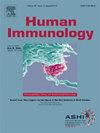Association of killer cell immunoglobulin-like receptor genes with primary Sjögren’s syndrome among Chinese population
IF 3.1
4区 医学
Q3 IMMUNOLOGY
引用次数: 0
Abstract
Background
Primary Sjögren’s syndrome (pSS) is a chronic and common autoimmune disorder which is caused by inflammatory infiltration of the exocrine glands salivary glands and lacrimal glands are the main sites of involvement. Killer cell immunoglobulin-like receptors (KIRs), are crucial for the development and function of natural killer (NK) cells. Moreover, the activity of NK cells is affected by the interaction of KIRs with HLA class I ligands. The pathogenesis of autoimmune diseases has been linked to some KIR genes. Further research on the relationship between KIR and these autoimmune diseases is of great significance for the diagnosis and treatment of these diseases. This study aimed to detect and analyze the connection between the polymorphism of the KIR and HLA-Cw genes and the pathogenesis of pSS.
Methods
We took 56 pSS patients as the study group and 32 healthy people as the control group. Blood samples were collected to perform a polymerase chain reaction with sequence specific primers (PCR-SSP). Then a comparative analysis of gene frequencies of 16 KIR genes and HLA-Cw in the two groups was performed.
Results
The genotype frequencies of both KIR2DS3 (P = 0.0027) and KIR3DS1 (P = 0.006) were significantly lower in patients with pSS compared to healthy individuals, indicating a negative correlation of these two activating KIR genes. There were more individuals who had more than three activating KIR genes in the control group than in the patient group (P = 0.004). And the KIR2DL1/HLA-C2 gene combination (P = 0.022) was significantly more in pSS group than in controls.
Conclusion
Our results may imply that via influencing the activity, development, capacitation, and functionality of NK cells, NKT cells, and part T cells, the decrease of activated KIR genes and the increase of the frequency of the inhibitory KIR and its specific ligand gene combination(KIR2DL1/HLA-C2) may contribute to the pathogenesis of pSS.
求助全文
约1分钟内获得全文
求助全文
来源期刊

Human Immunology
医学-免疫学
CiteScore
5.40
自引率
7.40%
发文量
107
审稿时长
12 days
期刊介绍:
The journal''s scope includes understanding the genetic and functional mechanisms that distinguish human individuals in their immune responses to allografts, pregnancy, infections or vaccines as well as the immune responses that lead to autoimmunity, allergy or drug hypersensitivity. It also includes examining the distribution of the genes controlling these responses in populations.
Research areas include:
Studies of the genetics, genomics, polymorphism, evolution, and population distribution of immune-related genes
Studies of the expression, structure and function of the products of immune-related genes
Immunogenetics of susceptibility to infectious and autoimmune disease, and allergy
The role of the immune-related genes in hematopoietic stem cell, solid organ, and vascularized composite allograft transplant
Histocompatibility studies including alloantibodies, epitope definition, and T cell alloreactivity
Studies of immunologic tolerance and pregnancy
T cell, B cell, NK and regulatory cell functions, particularly related to subjects within the journal''s scope
Pharmacogenomics and vaccine development in the context of immune-related genes
Human Immunology considers immune-related genes to include those encoding classical and non-classical HLA, KIR, MIC, minor histocompatibility antigens (mHAg), immunoglobulins, TCR, BCR, proteins involved in antigen processing and presentation, complement, Fc receptors, chemokines and cytokines. Other immune-related genes may be considered.
Human Immunology is also interested in bioinformatics of immune-related genes and organizational topics impacting laboratory processes, organ allocation, clinical strategies, and registries related to autoimmunity and transplantation.
 求助内容:
求助内容: 应助结果提醒方式:
应助结果提醒方式:


